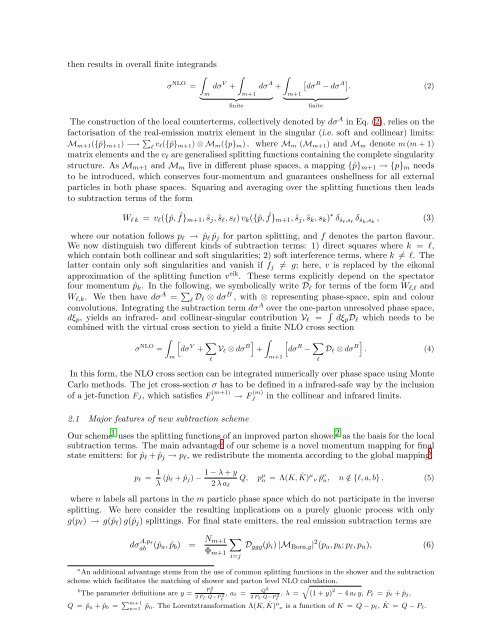2011 QCD and High Energy Interactions - Rencontres de Moriond ...
2011 QCD and High Energy Interactions - Rencontres de Moriond ...
2011 QCD and High Energy Interactions - Rencontres de Moriond ...
Create successful ePaper yourself
Turn your PDF publications into a flip-book with our unique Google optimized e-Paper software.
then results in overall finite integr<strong>and</strong>s<br />
σ NLO <br />
= dσ<br />
m<br />
V <br />
+ dσ<br />
m+1<br />
A<br />
<br />
finite<br />
<br />
<br />
+<br />
R A<br />
dσ − dσ<br />
m+1<br />
<br />
. (2)<br />
<br />
finite<br />
<br />
The construction of the local counterterms, collectively <strong>de</strong>noted by dσA in Eq. (2), relies on the<br />
factorisation of the real-emission matrix element in the singular (i.e. soft <strong>and</strong> collinear) limits:<br />
Mm+1({ˆp}m+1) −→ <br />
ℓ vℓ({ˆp}m+1) ⊗ Mm({p}m), where Mm (Mm+1) <strong>and</strong> Mm <strong>de</strong>note m(m + 1)<br />
matrix elements <strong>and</strong> the vℓ are generalised splitting functions containing the complete singularity<br />
structure. As Mm+1 <strong>and</strong> Mm live in different phase spaces, a mapping {ˆp}m+1 → {p}m needs<br />
to be introduced, which conserves four-momentum <strong>and</strong> guarantees onshellness for all external<br />
particles in both phase spaces. Squaring <strong>and</strong> averaging over the splitting functions then leads<br />
to subtraction terms of the form<br />
Wℓ k = vℓ({ˆp, ˆ f}m+1, ˆsj, ˆsℓ, sℓ)vk({ˆp, ˆ f}m+1, ˆsj, ˆsk, sk) ∗ δˆsℓ,sℓ<br />
δˆsk,sk , (3)<br />
where our notation follows pℓ → ˆpℓ ˆpj for parton splitting, <strong>and</strong> f <strong>de</strong>notes the parton flavour.<br />
We now distinguish two different kinds of subtraction terms: 1) direct squares where k = ℓ,<br />
which contain both collinear <strong>and</strong> soft singularities; 2) soft interference terms, where k = ℓ. The<br />
latter contain only soft singularities <strong>and</strong> vanish if fj = g; here, v is replaced by the eikonal<br />
approximation of the splitting function veik . These terms explicitly <strong>de</strong>pend on the spectator<br />
four momentum ˆpk. In the following, we symbolically write Dℓ for terms of the form Wℓ,ℓ <strong>and</strong><br />
Wℓ,k. We then have dσA = <br />
ℓ Dℓ ⊗ dσB , with ⊗ representing phase-space, spin <strong>and</strong> colour<br />
convolutions. Integrating the subtraction term dσA over the one-parton unresolved phase space,<br />
dξp, yields an infrared- <strong>and</strong> collinear-singular contribution Vℓ = dξpDℓ which needs to be<br />
combined with the virtual cross section to yield a finite NLO cross section<br />
σ NLO <br />
= dσ V + <br />
Vℓ ⊗ dσ B<br />
<br />
+<br />
m<br />
ℓ<br />
m+1<br />
<br />
dσ R − <br />
Dℓ ⊗ dσ B<br />
. (4)<br />
In this form, the NLO cross section can be integrated numerically over phase space using Monte<br />
Carlo methods. The jet cross-section σ has to be <strong>de</strong>fined in a infrared-safe way by the inclusion<br />
of a jet-function FJ, which satisfies F (m+1)<br />
J → F (m)<br />
J in the collinear <strong>and</strong> infrared limits.<br />
2.1 Major features of new subtraction scheme<br />
Our scheme 1 uses the splitting functions of an improved parton shower 2 as the basis for the local<br />
subtraction terms. The main advantage a of our scheme is a novel momentum mapping for final<br />
state emitters: for ˆpℓ + ˆpj → pℓ, we redistribute the momenta according to the global mapping b<br />
pℓ = 1<br />
λ (ˆpℓ<br />
1 − λ + y<br />
+ ˆpj) − Q, p<br />
2λaℓ<br />
µ n = Λ(K, ˆ K) µ ν ˆp ν n, n /∈ {ℓ,a,b}, (5)<br />
where n labels all partons in the m particle phase space which do not participate in the inverse<br />
splitting. We here consi<strong>de</strong>r the resulting implications on a purely gluonic process with only<br />
g(pℓ) → g(ˆpℓ)g(ˆpj) splittings. For final state emitters, the real emission subtraction terms are<br />
dσ A,pℓ<br />
ab (ˆpa, ˆpb) = Nm+1<br />
<br />
Dggg(ˆpi) |MBorn,g|<br />
Φm+1<br />
i=j<br />
2 (pa, pb; pℓ, pn), (6)<br />
a<br />
An additional advantage stems from the use of common splitting functions in the shower <strong>and</strong> the subtraction<br />
scheme which facilitates the matching of shower <strong>and</strong> parton level NLO calculation.<br />
b Q<br />
The parameter <strong>de</strong>finitions are y =<br />
2<br />
q<br />
, λ = (1 + y) 2 − 4 aℓ y, Pℓ = ˆpℓ + ˆpj,<br />
P 2 ℓ<br />
2 Pℓ·Q−P 2 , aℓ =<br />
ℓ<br />
2 P ℓ·Q−P 2 ℓ<br />
Q = ˆpa + ˆpb = P m+1<br />
n=1 ˆpn. The Lorentztransformation Λ(K, ˆ K) µ ν is a function of K = Q − pℓ, ˆ K = Q − Pℓ.<br />
ℓ








![List of participants 27/2/09 [pdf] - Rencontres de Moriond - IN2P3](https://img.yumpu.com/17975746/1/190x135/list-of-participants-27-2-09-pdf-rencontres-de-moriond-in2p3.jpg?quality=85)







